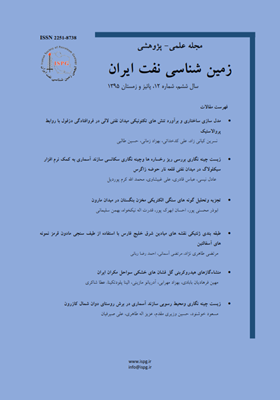منشا گازهای هیدروکربوری گل¬فشان¬های خشکی سواحل مکران ایران
محورهای موضوعی : ژئوشیمیمهین فرهادیان بابادی 1 * , بهزاد مهرابی 2 , آدریانو مازینی 3 , الینا پلودتکینا 4 , عطا شاکری 5
1 - دانشگاه خوارزمی
2 - دانشگاه خوارزمی
3 - دانشگاه نروژ
4 - دانشگاه ایالتی مسکو
5 - دانشگاه خوارزمی
کلید واژه: گل¬, فشان ترکیب شیمیایی گاز ایزوتوپ کربن و هیدروژن منشا گازها منشورهای برافزایشی مکران ایران بربروک عین سندمیرسوبان,
چکیده مقاله :
گل فشان ها، ساختارهای زمین شناسی ناشی از خروج گاز، گلآب و خرده های سنگی با ابعاد مختلف در مناطق خشکی و ساحلی با مرفولوژی های متفاوت و نشانگر حرکت پوسته ای و فعالیت تکتونیکی امروزی هستند. گل فشان های زیادی در منشورهای برافزایشی مکران ایران و پاکستان گزارش شده است که به دلیل برخورد صفحات هند و اوراسیا تشکیل می شوند. در این مطالعه، منشا گازهای هیدروکربوری گسیل شده از سه گل فشان فعال عین، بربروک و سندمیرسوبان در سواحل خشکی مکران ایران بررسی شده است. گازهای خارج شده از این گل فشان ها عمدتا متان با غلظت بین vol.% ۱۸/۹۹-۲۴/۹۷ و مقدار کمی اتان (vol.% ۲/۱-۰۴۸/۰)، پروپان (vol.% ۱۹۴/۰-۰۰۱/۰)، ان-بوتان (ppmvol.% ۲۲-)، ایزوبوتان(ppmvol.% ۳۶۳-۵)، ان-پنتان (ppmvol.% ۳۷)، ایزوپنتان (ppmvol.% ۶۶-۱)، هگزان (ppmvol.% ۷۸-۱) و دی اکسیدکربن (vol.% ۴/۰-۰۷/۰) هستند. مقادیر نسبت ایزوتوپی کربن و هیدروژن متان و دیگر گازهای هیدروکربوری نشاندهنده ی منشا ترموژنیک گازهای خروجی از گل فشان های مورد مطالعه است و شواهدی از عدم تجزیه زیستی را نشان می دهند. دی اکسیدکربن نیز با نسبت ایزوتوپی کربن ۱/۱۱- تا ‰ ۳/۱۴- دارای منشا آلی است. نتایج این مطالعه، حضور سیستم های هیدروکربوری و سنگ منشا فعال را در این ناحیه تکتونیکی فعال نشان می دهد. اگرچه حضور مخزن گازی در این منطقه بایستی توسط مطالعات ژئوفیزیکی، زمین شناسی و محیط های ساختاری تایید شود.
Mud volcanoes are geological structures formed as a result of gas emission, mud-fluid mixing and variably sized rock fragments in onshore and offshore settings. These structures are different morphologically which considered as significant marker of modern crustal movement and neotectonic activity. Occurrence of numerous mud volcanoes on the Makran accretionary prisms in Iran and Pakistan are reported which caused by the convergence of the Arabian and the Eurasian plates. In this study, origin of discharged hydrocarbon gases from three active onshore mud volcanoes; Ain, Borborok and Sand Mirsuban in Makran coasts of Iran were examined. The released gases of all these mud volcanoes are dominantly methane with concentration between 97.24-99.18 vol. % and minor amount of ethane (0.04-1.2 vol.%), propane (0.001-0.194 vol.%), n-butane (226 ppmvol.%), iso-butane (5-363 ppmvol.%), n-pentane (37ppmvol.%), iso-pentane (1-66 ppmvol.%), hexane (1-78 ppmvol.%) and CO2 (0.07-0.4 vol.%). Carbon and hydrogen isotope ratio of methane and its heavier derivatives indicate thermogenic source for emitted gases of all investigated mud volcanoes and evidences of the absence of biodegradation. CO2 with carbon isotope ratio of -11.1 to -14.3‰ is organic in origin. Our research suggests the presence of hydrocarbon system and active source rock in Makran active tectonic area. Although the occurrence of an exploitable gas reservoir in this area has to be confirmed by geophysical measurements, geological survey and structural settings.

